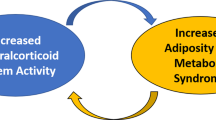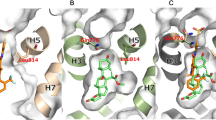Abstract
Increasing recognition of the role of aldosterone in cardiovascular disease has been supported by a significant body of evidence from animal models. This evidence has been translated into clinical practice, and large-scale, randomized, placebo-controlled trials have confirmed the beneficial effects of mineralocorticoid blockade in patients with heart failure. As a consequence, there has been a resurgence in the use of mineralocorticoid-receptor antagonists in clinical practice that has prompted the search for a potent and specific antagonist without the sexual side effects of spironolactone. Eplerenone, a mineralocorticoid-receptor antagonist with minimal binding to the progesterone and androgen receptors, is now licensed for treatment of heart failure in Europe and heart failure and hypertension in the US; it has also been proposed as a treatment for a variety of cardiovascular conditions. This article reviews the current concepts of the actions of aldosterone at a cellular level. Recent findings regarding its role as a cardiovascular hormone, both in animal models and human studies, are discussed. We also describe the development of mineralocorticoid-receptor blockers following the isolation of aldosterone and discuss the subsequent search for a specific mineralocorticoid antagonist. In addition we detail the effects of eplerenone in a number of clinical situations and outline its potential future applications.
Key Points
-
There is increasing evidence that aldosterone has a key role in cardiovascular pathology
-
Experimental data suggest that mineralocorticoid blockade is beneficial in models of hypertension, nephropathy and heart failure
-
Mineralocorticoid blockade has proved a valuable therapeutic option in clinical studies of heart failure and after myocardial infarction
-
Few data exist regarding outcomes in large cohorts of patients in other cardiovascular conditions (e.g. nephropathy, hypertension) and these are required, as well as confirmatory studies in heart failure, to establish the role of eplerenone in clinical practice
This is a preview of subscription content, access via your institution
Access options
Subscribe to this journal
Receive 12 print issues and online access
$209.00 per year
only $17.42 per issue
Buy this article
- Purchase on Springer Link
- Instant access to full article PDF
Prices may be subject to local taxes which are calculated during checkout

Similar content being viewed by others
References
Funder JW (1995) Mineralocorticoid receptors and hypertension. J Steroid Biochem Mol Biol 53: 53–55
Losel R et al. (2004) A quick glance at rapid aldosterone action. Mol Cell Endocrinol 217: 137–141
MacKenzie SM et al. (2002) Local renin–angiotensin systems and their interactions with extra-adrenal corticosteroid production. J Renin Angiotensin Aldosterone Syst 3: 214–221
Connell JM and Davies E (2002) The new biology of aldosterone. J Endocrinol 186: 1–20
Penfornis P et al. (2000) The mineralocorticoid receptor mediates aldosterone-induced differentiation of T37i cells into brown adipocytes. Am J Physiol Endocrinol Metab 279: E386–E394
Gomez-Sanchez EP (2004) Brain mineralocorticoid receptors: orchestrators of hypertension and end-organ disease. Curr Opin Nephrol Hypertens 13: 191–196
Rocha R (2002) Aldosterone induces a vascular inflammatory phenotype in the rat heart. Am J Physiol Heart Circ Physiol 283: H1802–H1810
Pitt B et al. (2003) Mineralocorticoid receptor blockade: new insights into the mechanism of action in patients with cardiovascular disease. J Renin Angiotensin Aldosterone Syst 4: 164–168
Young MJ et al. (2003) Early inflammatory responses in experimental cardiac hypertrophy and fibrosis: effects of 11 β-hydroxysteroid dehydrogenase inactivation. Endocrinology 144: 1121–1125
Funder JW (2005) RALES, EPHESUS and redox. J Steroid Biochem Mol Biol 93: 121–125
Lim PO et al. (1999) Potentially high prevalence of primary aldosteronism in a primary-care population. Lancet 353: 40
Calhoun DA et al. (2002) Hyperaldosteronism among black and white subjects with resistant hypertension. Hypertension 40: 892–896
Rossi GP et al. (2006) A prospective study of the prevalence of primary aldosteronism in 1,125 hypertensive patients. J Am Coll Cardiol 48: 2293–2300
Rossi GP et al. (1996) Changes in left ventricular anatomy and function in hypertension and primary aldosteronism. Hypertension 27: 1039–1045
Milliez P et al. (2005) Evidence for an increased rate of cardiovascular events in patients with primary aldosteronism. J Am Coll Cardiol 45: 1243–1248
Vasan RS et al. (2004) Serum aldosterone and the incidence of hypertension in nonhypertensive persons. N Engl J Med 351: 33–41
Newton-Cheh C et al. (2007) Clinical and genetic correlates of aldosterone-to-renin ratio and relations to blood pressure in a community sample. Hypertension 49: 846–856
Beygui F et al. (2006) High plasma aldosterone levels on admission are associated with death in patients presenting with acute ST-elevation myocardial infarction. Circulation 114: 2604–2610
Vantrimpont P et al. (1998) Two-year time course and significance of neurohumoral activation in the Survival and Ventricular Enlargement (SAVE) Study. Eur Heart J 19: 1552–1563
Swedberg K et al. (1990) Hormones regulating cardiovascular function in patients with severe congestive heart failure and their relation to mortality. CONSENSUS Trial Study Group. Circulation 82: 1730–1736
Guder G et al. (2007) Complementary and incremental mortality risk prediction by cortisol and aldosterone in chronic heart failure. Circulation 115: 1754–1761
Brilla CG et al. (1990) Remodeling of the rat right and left ventricles in experimental hypertension. Circ Res 67: 1355–1364
Rocha R et al. (1998) Mineralocorticoid blockade reduces vascular injury in stroke-prone hypertensive rats. Hypertension 31: 451–458
Rocha R et al. (2000) Aldosterone: a mediator of myocardial necrosis and renal arteriopathy. Endocrinology 141: 3871–3878
Blasi ER et al. (2003) Aldosterone/salt induces renal inflammation and fibrosis in hypertensive rats. Kidney Int 63: 1791–1800
McKelvie RS et al. (1999) Comparison of candesartan, enalapril, and their combination in congestive heart failure: Randomized Evaluation of Strategies for Left Ventricular Dysfunction (RESOLVD) pilot study. The RESOLVD Pilot Study Investigators. Circulation 100: 1056–1064
Lee AF et al. (1999) Neurohormonal reactivation in heart failure patients on chronic ACE inhibitor therapy: a longitudinal study. Eur J Heart Fail 1: 401–406
Pitt B et al. (1999) The effect of spironolactone on morbidity and mortality in patients with severe heart failure. Randomized Aldactone Evaluation Study Investigators. N Engl J Med 341: 709–717
Tait SAS et al. (2004) The discovery, isolation and identification of aldosterone: reflections on emerging regulation and function. Mol Cell Endocrinol 217: 1–21
Jeunemaitre X et al. (1987) Efficacy and tolerance of spironolactone in essential hypertension. Am J Cardiol 60: 820–825
Chapman N et al. (2007) Effect of spironolactone on blood pressure in subjects with resistant hypertension. Hypertension 49: 839–845
Nishizaka MK et al. (2003) Efficacy of low-dose spironolactone in subjects with resistant hypertension. Am J Hypertens 16: 925–930
Lane DA et al. (2007) Low-dose spironolactone in the management of resistant hypertension: a surveillance study. J Hypertens 25: 891–894
McInnes GT et al. (1982) Relative potency and structure activity relationships of aldosterone antagonists in healthy man: correlation with animal experience. Br J Clin Pharmacol 13: 331–339
De Gasparo M et al. (1987) Three new epoxy-spirolactone derivatives: characterization in vivo and in vitro . J Pharmacol Exp Ther 240: 650–656
De Gasparo M et al. (1989) Antialdosterones: incidence and prevention of sexual side effects. J Steroid Biochem 32: 223–227
Lacolley P et al. (2002) Increased carotid wall elastic modulus and fibronectin in aldosterone-salt-treated rats: effects of eplerenone. Circulation 106: 2848–2853
Rajagopalan S et al. (2002) Mineralocorticoid receptor antagonism in experimental atherosclerosis. Circulation 105: 2212–2216
Suzuki J et al. (2006) Eplerenone with valsartan effectively reduces atherosclerotic lesion by attenuation of oxidative stress and inflammation. Arterioscler Thromb Vasc Biol 26: 917–921
Takai S et al. (2005) Eplerenone inhibits atherosclerosis in nonhuman primates. Hypertension 46: 1135–1139
Endemann DH et al. (2004) Eplerenone prevents salt-induced vascular remodeling and cardiac fibrosis in stroke-prone spontaneously hypertensive rats. Hypertension 43: 1252–1257
Rocha R et al. (1999) Role of aldosterone in renal vascular injury in stroke-prone hypertensive rats. Hypertension 33: 232–237
Zhou X et al. (2004) Aldosterone antagonism ameliorates proteinuria and nephrosclerosis independent of glomerular dynamics in L-NAME/SHR model. Am J Nephrol 24: 242–249
Guo C et al. (2006) Mineralocorticoid receptor antagonist reduces renal injury in rodent models of types 1 and 2 diabetes mellitus. Endocrinology 147: 5363–5373
Burgess ED et al. (2003) Long-term safety and efficacy of the selective aldosterone blocker eplerenone in patients with essential hypertension. Clin Ther 25: 2388–2404
Weinberger MH et al. (2002) Eplerenone, a selective aldosterone blocker, in mild-to-moderate hypertension. Am J Hypertens 15: 709–716
Juurlink DN et al. (2004) Rates of hyperkalemia after publication of the Randomized Aldactone Evaluation Study. N Engl J Med 351: 543–551
White WB et al. (2003) Effects of the selective aldosterone blocker eplerenone versus the calcium antagonist amlodipine in systolic hypertension. Hypertension 41: 1021–1026
Williams GH et al. (2004) Efficacy of eplerenone versus enalapril as monotherapy in systemic hypertension. Am J Cardiol 93: 990–996
Weinberger MH et al. (2005) Effects of eplerenone versus losartan in patients with low-renin hypertension. Am Heart J 150: 426–433
Flack JM et al. (2003) Efficacy and tolerability of eplerenone and losartan in hypertensive black and white patients. J Am Coll Cardiol 41: 1148–1155
Prisant LM et al. (2003) Can renin status predict the antihypertensive efficacy of eplerenone add-on therapy? J Clin Pharmacol 43: 1203–1210
Krum H et al. (2002) Efficacy of eplerenone added to renin-angiotensin blockade in hypertensive patients. Hypertension 40: 117–123
Pitt B et al. (2003) Effects of eplerenone, enalapril, and eplerenone/enalapril in patients with essential hypertension and left ventricular hypertrophy: the 4E-left ventricular hypertrophy study. Circulation 108: 1831–1838
Sato A et al. (2003) Effectiveness of aldosterone blockade in patients with diabetic nephropathy. Hypertension 41: 64–68
Epstein M et al. (2006) Selective aldosterone blockade with eplerenone reduces albuminuria in patients with type 2 diabetes. Clin J Am Soc Nephrol 1: 940–951
Pitt B et al. (2003) Eplerenone, a selective aldosterone blocker, in patients with left ventricular dysfunction after myocardial infarction. N Engl J Med 348: 1309–1321
Suzuki G et al. (2002) Effects of long-term monotherapy with eplerenone, a novel aldosterone blocker, on progression of left ventricular dysfunction and remodeling in dogs with heart failure. Circulation 106: 2967–2972
Zannad F et al. (2000) Limitation of excessive extracellular matrix turnover may contribute to survival benefit of spironolactone therapy in patients with congestive heart failure: insights from the Randomized Aldactone Evaluation Study (RALES). RALES Investigators. Circulation 102: 2700–2706
Shroff SC et al. (2006) Selective aldosterone blockade suppresses atrial tachyarrhythmias in heart failure. J Cardiovasc Electrophysiol 17: 534–541
De Mello WC (2006) Beneficial effect of eplerenone on cardiac remodelling and electrical properties of the failing heart. J Renin Angiotensin Aldosterone Syst 7: 40–46
Farquharson CA and Struthers AD (2002) Increasing plasma potassium with amiloride shortens the QT interval and reduces ventricular extrasystoles but does not change endothelial function or heart rate variability in chronic heart failure. Heart 88: 475–480
Joffe HV et al. (2007) Beneficial effects of eplerenone versus hydrochlorothiazide on coronary circulatory function in patients with diabetes mellitus. J Clin Endocrinol Metab 92: 2552–2558
Swedberg K et al. (2005) Guidelines for the diagnosis and treatment of chronic heart failure: executive summary (update 2005): The Task Force for the Diagnosis and Treatment of Chronic Heart Failure of the European Society of Cardiology. Eur Heart J 26: 1115–1140
Cleland JG et al. (2007) Clinical trials update from the American College of Cardiology 2007: ALPHA, EVEREST, FUSION II, VALIDD, PARR-2, REMODEL, SPICE, COURAGE, COACH, REMADHE, pro-BNP for the evaluation of dyspnoea and THIS-diet. Eur J Heart Fail 9: 740–745
Author information
Authors and Affiliations
Corresponding author
Ethics declarations
Competing interests
The authors declare no competing financial interests.
Rights and permissions
About this article
Cite this article
McManus, F., McInnes, G. & Connell, J. Drug Insight: eplerenone, a mineralocorticoid-receptor antagonist. Nat Rev Endocrinol 4, 44–52 (2008). https://doi.org/10.1038/ncpendmet0676
Received:
Accepted:
Issue Date:
DOI: https://doi.org/10.1038/ncpendmet0676
This article is cited by
-
Macrophage-mediated inflammation in metabolic disease
Nature Reviews Immunology (2011)
-
Effects of selective mineralocorticoid receptor antagonism on atrial ion currents and early ionic tachycardia-induced electrical remodelling in rabbits
Naunyn-Schmiedeberg's Archives of Pharmacology (2010)
-
Cardiovascular effects of aldosterone blockade in CKD
Nature Reviews Cardiology (2009)
-
Diuretika – tubuläre Wirkmechanismen und nephrologische Indikationen
Der Nephrologe (2008)



